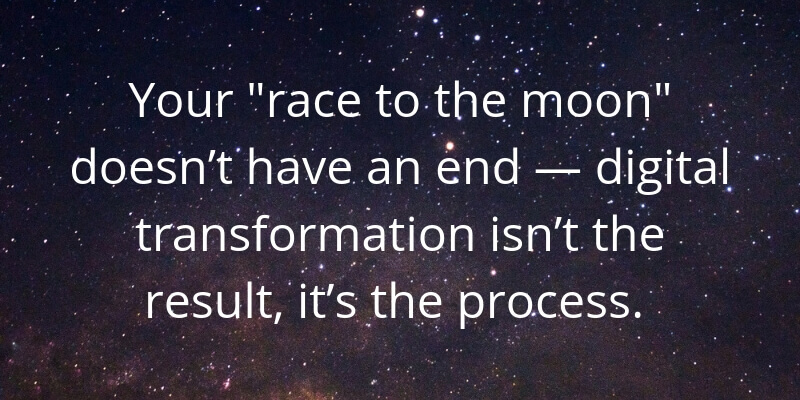The Cold War is over but the “race to the moon” of the 21st Century has just begun.
The race to the moon was about dominance. Whichever nation could be first to conquer this new frontier, take the first step, and raise their flag would establish itself as the new world superpower. It was not only a show of technological superiority but of unprecedented global authority.
The race for supremacy doesn’t end there.
Winning in the digital business frontier does not only mean building up your arsenal of technology. It’s not just about using digital tools to achieve your strategic goals. It’s about using new capabilities to differentiate yourself and dominate the competition.
No one remembers the second person to walk on the moon
If you want to be the dominant force in your market, you need to come in first. You not only need to have the right digital tools, but you must use them to win.
So what will it be? Will you revel in first place, or will you be the unknown in second?
Winning in the digital age: How to be No. 1
Today, everyone is doing digital transformation. While it used to be considered competitive or ambitious, now it’s the bare minimum effort companies must make to stay relevant.
If you want to be a pioneer, if you want everyone to know your company, brand, and you, you have to push your digital initiatives one step further.
You need to know how to drive digital adoption: achieving a state in which digital tools are used as intended and to their fullest extent. In other words, it’s not just building a spaceship, but taking it all the way to the moon.
Winning your race demands fiercely competitive leadership and an unwavering commitment to innovation. Here are four questions to help you come in first place.
Dive deeper: How smart CEOs decode digital transformation to make it work.
1. Is your end goal competitive?
The goal that drives your digital adoption strategy must be more than simply achieving a high ROI on your software investment. It’s about using technology to soar ahead of your competition.
By 1961, the Soviet Union had already successfully launched the first satellite and human into space. President John F. Kennedy knew reclaiming the lead in the space race would require a major push.
He and the director of recently formed NASA defined a goal that would guarantee victory: a crewed moon landing. The Apollo program was born.
The next step was designing the strategy. In addition to developing spacecraft technology, the plan needed to address usability.
Your strategy must answer the question: How can you ensure your technology is used to its fullest extent while minimizing demands on users?
2. Do your people know how to use your technology?
Your approach to training determines how well users can operate your technology.
The Apollo astronauts underwent rigorous training for nearly a decade to maximize their chances for a successful mission. Failure to adopt the spacecraft technology would have catastrophic consequences.
In addition to flight tests and simulations, the men who went to the moon relied on written manuals to learn how to operate the shuttle.
You don’t have this luxury. The pace of change in the digital business landscape is fast and always accelerating.
Achieving the desired level of usability demands an effective and agile approach to training.
Be smart: You won’t achieve digital adoption after a few simulations, or even after marathon classroom sessions.
Next on your reading list: The training manifesto for driving software adoption.
Choose a solution that provides real-time guidance and support to ensure your users can perform any task in the moment of need. If you don’t have it in high-pressure situations, well — you know what could happen.
3. Do you have metrics for measuring success?
If you land a man on the moon, you know you’ve succeeded. But what about while you’re still on your journey? You need a system to gauge whether or not you are still on course.
Without metrics for monitoring progress, you won’t know when to course correct, or how to drive digital adoption.
Just as NASA measured its progress via experiments, simulations, and pilot programs, you must have a framework for identifying what’s working and what’s not in your digital adoption strategy.
What criteria will you use? What are the most important milestones and indicators to your mission? Without defining these, it will be impossible to track your success.
4. Are you mentally prepared for a race with no end?
Succeeding in the race to the moon required extreme levels of mental strength, stamina, and determination.
When Russia put the first man in space, US leaders didn’t throw up their hands and think, “It’s over. We’ve lost.”
They did the opposite. They established NASA, recruited the nations smartest engineers, and initiated the race to the moon. They pushed forward with relentless conviction. They didn’t stop until they won.
The difference is your race doesn’t have an end — digital transformation isn’t the result, it’s the process. As technology continues to develop, you have to be prepared to continually redefine the finish line.
Are you mentally prepared for an unending mission? Are your employees? Coming in first place demands determination and a strong will to constantly evolve. How will you rouse your people to rise to the challenge?
So, do you have what it takes to win?
Coming in first place often means creating your own race. You need the grit to face the challenge at hand and the courage to create new ones. That’s how you conquer new frontiers.
Digital transformation is only a small piece of the larger mission. You must know how to drive digital adoption in order to use new technology to dominate your competitors.
In a digitally saturated market, it’s the only way to stand out in the eyes of your customers and win.
__________
WalkMe’s Digital Adoption Platform (DAP) transforms the user experience in today’s overwhelming digital world. Using artificial intelligence, engagement, guidance, and automation, WalkMe’s transparent overlay assists users to complete tasks easily within any enterprise software, mobile application or website. Discover how a DAP can revolutionize your business — request a demo today.




